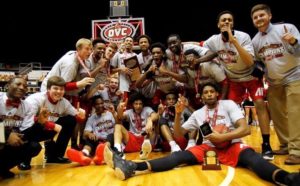Missouri Valley
Who Is Cracking the RPI Code?
(St. Louis, MO) – Mid major conference teams are constantly working on winning games, creating a fan base and building a program. But almost just as important to these teams is finding a way to build a resume and cultivate an RPI rating that can help them into the NCAA Tournament.
So which Ohio Valley and Missouri Valley Conference teams are doing the best job at cracking the RPI code? You might be surprised by what we’ve found.
What is the RPI?
RPI stands for Ratings Percentage Index. The math for the RPI is mind-numbing, but the categories are fairly straight forward. The problem isn’t with the math, but with the formula. Did you realize that 75% of a team’s RPI has nothing to do with their own record? You have to begin to question the whole premise of the rating system.
Did you realize that 75% of a team’s RPI has nothing to do with its own record?
There are three numbers to crunch. Factor 1 is the team’s winning percentage. That percentage of Division 1 games equals 25 percent of the equation. Factor 2 makes up 50 percent of the RPI. It is the winning percentage of the team’s opponents. Then, Factor 3, which is equal to the team’s own winning percentage (25%) is the winning percentage of the team’s opponents’ opponents.
In other words, when Missouri State plays Southeast Missouri, SEMO’s winning percentage is part of the formula that is more important that Missouri State’s and SEMO’s opponents’ opponents combined winning percentages are just as important as that belonging to the Bears. Because SEMO lost to Indiana, every time the Hoosiers win, so do the Bears of Missouri State!
How does that make sense?
Back to who’s effectively cracked the code.
Clearly the best Missouri Valley team at working the system are the Northern Iowa Panthers. UNI is 2-4 and yet owns a 65 RPI because they’ve played teams with good records. Their RPI will only get better! Their two wins are against ‘power five’ teams (Arizona State and Oklahoma). Two of their losses are to nationally ranked Xavier. Those teams will most likely finish with strong records, and the Panthers will benefit.
Since ‘money conference’ teams build up winning percentages during the non-conference season by playing weaker teams at home and then build up their RPI by playing against one another in the league schedule, they are guaranteed to have a good RPI. When Northern Iowa can fight their way on to a Big 12 team’s schedule, they gain big RPI benefits. Their game with Oklahoma strengthens their RPI every time Kansas wins a game.
The Panthers still have Iowa (Big 10) and North Carolina (ACC) on their non-conference schedule. Ben Jacobson’s team routinely wins a couple of these games every year. If UNI can win one more ‘power 5’ game and then have a winning percentage in the MVC, they are most likely in the Big Dance, because their RPI will be undeniable. By playing UNC, every time Duke wins, that UNI RPI swells! Well done UNI! Their 65 RPI ranking (according to RealTimeRPI.com) will only improve, assuming they have an upper level MVC record.
Tennessee State is 6-1 and their RPI is 57, only eight places ahead UNI. Why? TSU’s schedule doesn’t include the same fire power as that of Northern Iowa’s. Dana Ford has done a nice job of improving his team’s schedule this season. A road game at Vanderbilt (the Tigers’ only loss) and a road win at 2016 NCAA qualifier Middle Tennessee and an upcoming game at North Carolina State are huge for the Tigers. However, other light weights on their schedule means their non-conference strength of schedule is currently ranked 217th in the country. That will improve significantly when they pay the Wolfpack.
Low winning percentages by the rest of the OVC teams will hinder TSU’s ability to improve their respectable RPI.
(Tennessee State Resurgence Going Strong)
Perhaps Austin Peay has done the best job of working the RPI system in the OVC. The Governors have the nation’s 42nd best strength of schedule. They have already played Dayton, Miami, Arkansas and will still play Indiana. Surprisingly a home and home series with Fort Wayne (66 RPI) has suddenly become a big ratings booster. APSU is 2-4 and owns the third best RPI in the OVC at 120.
Fort Wayne’s Mastadons are 5-2, own a big upset of Indiana and earns all kinds of bonus points for, you guessed it… Austin Peay!
It’s outdated, it is maddening and yet it is the system we all swear by. Seemingly Northern Iowa and Austin Peay have cracked the code and stand to benefit from its idiosyncrasies.
What would be a better system? Perhaps the NCAA could set up true geographic regions and let the teams fight their way out of their regions to make it to the national tournament. Or perhaps regular season conference champions AND tournament champions should receive automatic bids to the dance. That would thin the herd some of those fifth and sixth place teams from ‘money conferences’ making the tournament despite having a poor conference records. You could keep the RPI around to sort out the rest of the field if you want.
What do you think?
Do Good














